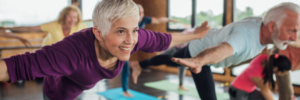How do you typically spend your time? Do you engage in activities that help develop a strong body, cultivate a clear mind, or relieve stress? Gentle yoga is an excellent form of exercise for seniors. Yoga postures can help relieve tired or sore muscles, increase mobility, improve balance, and keep your mind sharp. Enjoy peace of mind knowing that yoga is for everyone. You just need to find the style of yoga that best suits your needs. Read on to discover the benefits of yoga for seniors.
Increases or Maintains Joints’ Range of Motion
Elbows, knees, and hips are important for a range of motion. They determine how well you can move your joints. These joints connect and cushion bones with fluid and tissue. As a person ages, their joints may lose these connective tissues and cause pain and stiffness. Reduced range of motion could be caused by lack of activity, arthritis, injury, or tight muscles.
Oftentimes, seniors do not know how much range of motion they have lost until it becomes difficult to perform tasks, including cooking, getting dressed, showering, or walking. Fortunately, yoga’s rich variety of poses allows individuals to maintain or improve their joints’ ranges of motion. These exercises include standing poses, forward bending, back bending, twisting, and more.
Improves Strength and Balance
Adults who are 40 and above may start to lose muscle mass. These physical changes leave them feeling weaker than usual. If nothing is done, they may experience some loss of independence later in life. To prevent muscle loss, they must be used daily. Yoga allows seniors to safely challenge their muscles by supporting their body weight as they transition into different positions. In other words, yoga helps tone frequently used muscles and exercises the ones you don’t use every day.
Older adults are recommended to remain mobile in order to reduce their risk of falls. These accidents may lead to fractures, bruises, or even broken bones. Fall prevention involves building muscle strength and improving balance. Yoga ticks both of these boxes. These exercises enable you to understand your body better and connect you with your center of balance.
Improves Mood and Helps Reduce Feelings of Anxiety or Depression
Discovering that you are not as limber as you were before. Not being able to complete certain tasks by yourself. These age-related changes can cause us to become frustrated with ourselves. Yoga has the potential to lower stress hormones in our bodies and increase beneficial brain chemicals like endorphins. These feel-good chemicals help improve mood and decrease negative feelings associated with anxiety, depression, and anger. Seniors who regularly practice yoga typically notice an improvement in their mood. Try it, be patient, and keep your chin up. Don’t be too hard on yourself.
Promotes a Sense of Well-Being and Independence
When seniors lose their mobility, they lose a part of their independence. It is important to note that inaction may accelerate this process. Therefore, stay active by practicing the slow, controlled movements of yoga poses to improve balance and increase overall body awareness. These skills are necessary to prevent falls, which are the leading causes of injuries and loss of independence among older adults. In addition to the physical benefits of yoga, you can also sharpen your concentration, center your attention, relax your mind, and relieve chronic stress patterns.
Improves Blood Circulation
- Feeling lightheaded, dizzy, or tired all the time.
- Experiencing muscle cramps
- Cold, numb, or pins and needles in extremities (i.e., feet, toes, hands, and fingers)
To alleviate these common symptoms of poor blood circulation, try chair yoga exercises. They are designed to help loosen and stretch painful muscles, reduce stress, and improve circulation. You will be performing modified yoga poses while seated in a chair, e.g., overhead stretches, neck stretches, reverse arm holds, eagle arms, cat-cow stretches, and more. This option is recommended for individuals who find it difficult to stand or are unable to easily switch from seated to standing to lying positions.

Cultivates Better Sleeping Habits
Yoga has been shown to improve the quality of sleep for seniors because it is a form of exercise. Frequent movement is an essential ingredient for good sleep hygiene. Therefore, seniors should engage in moderate exercise several times a week. Breathing regulation and awareness are also important elements of yoga. Deep breathing is a well-known relaxation technique that can help induce sleep.
When people do yoga, they also practice mindfulness. Being in the moment and practicing judgment-free awareness helps increase melatonin levels and reduce nighttime sleep disturbances. For example, restless leg syndrome (RLS), insomnia, and snoring.
Helps Reduce Common Aches Associated with Aging
Although yoga is not a cure for pain, it can help alleviate common age-related aches. Yoga is especially beneficial to those suffering from physical limitations or medical conditions like osteoarthritis. This form of exercise teaches you how to breathe and relax through pain. Let negative sensations ebb away and the chronic pain diminish.
Keeps Your Mind Sharp
“Exercising the mind is just as important as exercising the body.” This saying holds true for seniors. Yoga practice combines basic meditation techniques to help individuals stay centered and energized. Regular yoga sessions enable you to focus on your thoughts and feelings and achieve a higher level of self-awareness. This way, you can maintain mental well-being, be observant, make better decisions, and more.
FAQs about Yoga for Seniors
How often should seniors do yoga?
Seniors who are interested in yoga should always start small. Join a beginner’s class or work with a qualified yoga instructor even if you feel fit and healthy. Choose yoga classes that teach how to balance exertion with relaxation. Take time to learn how to move into a position so that you avoid straining yourself.
What type of yoga is best for seniors?
For safety reasons, older adults should also consult with their doctors before attempting yoga. Do this if you are highly sedentary or have a chronic illness. Individuals with glaucoma or spinal disc disorders must take extra care and avoid twisting yoga postures.
If you are interested in taking up yoga, Simple Life offers everything residents need for restorative and peaceful yoga practice sessions for seniors. Equipment includes straps, yoga pillows, yoga mats, and more.





